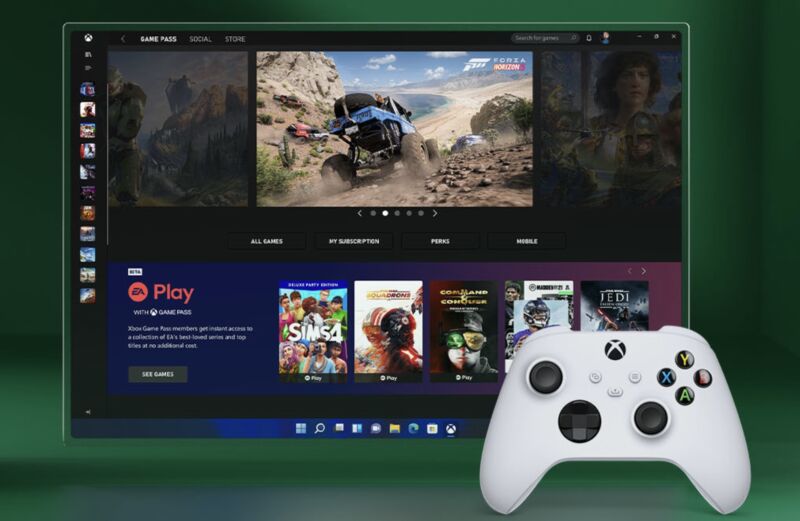There was a time shortly after Windows 10's release when Microsoft would release specific adoption numbers frequently, trumpeting how quickly the then-novel free update was being adopted by users of Windows 7 and Windows 8. The company hasn't repeated that strategy for Windows 11, leaving us to rely on third-party data to see how quickly people are picking up the new OS.
We've pulled a few months' worth of the Steam Hardware & Software Survey data and compared it to the months immediately following Windows 10's release. This data is imperfect and inevitably a bit noisy—Steam users need to volunteer to send in the data—but the disparity in adoption is large enough that we can draw at least some conclusions.
Windows 11 was released to the public in October 2021, and Windows 10 was released in July 2015. In both cases, we used the Internet Wayback Machine to dig up seven months of data, including the month immediately before the release of each operating system. We charted the usage numbers for 64-bit versions of the operating systems (32-bit versions, along with versions like Vista and XP, are lumped into "other"), combining the numbers for Windows 8.1 and 8.0.

Windows 11's adoption has been steady, but lower than Windows 10's early adoption.

Windows 10 benefitted from a lot of pent-up demand, taking a huge chunk of Windows 8's share in its first two months.
The upshot is that Steam users are migrating to Windows 11 about half as quickly as they moved to Windows 10. Six months after its release, Windows 10 ran on 31 percent of all Steam computers—nearly one in three. As of March 2022, Windows 11 runs on just under 17 percent of Steam computers—about one in six. Three-quarters of all Steam computers in 2022 are still running Windows 10.

The black wedge here represents non-Windows computers running Steam.

The black wedge here represents non-Windows computers running Steam.
It's easy to interpret these results as an indictment of Windows 11, which generated some controversy with its relatively stringent (and often poorly explained) security-oriented system requirements. At least some of this slow adoption is caused by those system requirements—many of the PCs surveyed by Steam probably can't install Windows 11. That could be because users have an older unsupported CPU or have one or more of the required security features disabled; Secure Boot and the firmware TPM module were often turned off by default on new motherboards for many years.
But there are other compelling explanations. Windows 11's adoption looks slow compared to Windows 10, but Windows 10's adoption was also exceptionally good.
Windows 8 and 8.1 were not well-loved, to put it mildly, and Windows 10 was framed as a response to (and a fix for) most of Windows 8's user interface changes. And people who were still on Windows 7 were missing out on some of the nice quality-of-life additions and under-the-hood improvements that Windows 8 added.
You can see that pent-up demand in the jump between July 2015 and September 2015. In the first two months of Windows 10's availability, Windows 8 hemorrhaged users, falling from around 35 percent usage to 19 percent. Virtually all of those users—and a smaller but still notable chunk of Windows 7 users—were moving to Windows 10. Windows 11 also got a decent early adopter bump in November 2021, but its gains every other month were much smaller.
In contrast, Windows 11 was announced with little run-up, and it was replacing what users had been told was the "last version of Windows." Where Windows 10 replaced one new, unloved OS and one well-liked but aging OS, Windows 11 replaced a modern OS that nobody really complained about (Windows 10 ran on over 90 percent of all Steam computers in September 2021—even Windows 7 in its heyday couldn't boast that kind of adoption).
It's also worth noting that Microsoft didn't try to re-create that initial burst of adoption for Windows 11. Following some turbulence after early Windows 10 servicing updates, Microsoft began rolling updates out more methodically, starting with small numbers of PCs and then expanding availability gradually as problems were discovered and ironed out. Windows 11 only entered "its final phase of availability" in February, ensuring that anyone with a compatible PC could get Windows 11 through Windows Update if they wanted it.



3175x175(CURRENT).thumb.jpg.b05acc060982b36f5891ba728e6d953c.jpg)
Recommended Comments
There are no comments to display.
Join the conversation
You can post now and register later. If you have an account, sign in now to post with your account.
Note: Your post will require moderator approval before it will be visible.